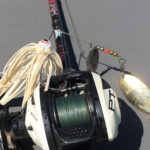
A wide selection of sizes and patterns are available to anglers utilizing bladed baits, and beyond the main three styles of blades other shapes can be used as well. Simonson Photo
By Nick Simonson
Late summer brings the bling on big baits and small ones too, and for any angler in just about any realm of fishing, flashy blades are a part of every late season arsenal. From big double-bladed bucktails cast for muskies, to crawler harnesses trolled for walleyes, to spinnerbaits burned for bass of both stripes, to in-line spinners deployed for stocked trout as the season fades, hungry fish are willing to chase a quickly pulled bait and are drawn to the rhythmic thump of a spinning blade and the additional flash it generates. Each type of blade, with its unique shape gives off a different vibe and requires a varying degree of force to get it to spin. Knowing what blades to employ will help increase the odds of success in late summer.
The Big Three
Now well established among bait companies and individuals assembling their own offerings, three blade styles comprise the primary selection open to anglers, they are the deep and wide Colorado blade, the slimmer Indiana blade, and the flashy and fluttery willow blade. Conjuring images of the vast and wide mountains of its namesake, the Colorado blade is a deeper-cupped pressing that takes a bit more force to get turning, but when it does, it generates a strong vibration that is easy for fish to pick up. Often employed on those double-bladed in-lines for muskies, to catch their attention, smaller versions of the blade work well on walleye spinners as well. In other instances, particularly in the practice of slow rolling a spinner bait, a single Colorado blade can be utilized on bass spinnerbaits as well to kick out some vibration, while not overdoing things with additional blades on the bait.
The Indiana blade is a slightly elongated cousin of the Colorado blade and isn’t nearly as deep in its cupping. It requires less force to turn as a result and makes for an ideal attractor on single blade lures such as in-line spinners for trout and moderately-sized bucktail offerings for smallmouth bass, pike and muskies. While it can be utilized on walleye spinners, it’s an uncommon choice but it remains available when the fish are fussy and require something with a little more subtlety.
Finally, in the mix of the main three blades is the willow blade. Aptly named for its shape matching the long and slender leaves on a willow tree, this blade gives off a subtle flickering action and in silver and gold generates a minnow-like flash. While seen once in a while in other applications, the willow blade features most prominently on bass spinnerbaits as a main blade as well as secondary blades along the lure’s metal arm. Combined in groups of two, three, or four, willow blades on such an offering provide the appearance of a school of growing summer minnows and trigger a reaction strike from both largemouth and smallmouth bass on the feed at this time of year.
Other Offerings
The market has long since expanded following the establishment of Colorado, Indiana and willow blades as primary options for anglers, and a number of blades made from various materials in a variety of shapes are now available to anglers looking to tweak their presentations. From smile blades and hatchet blades to discs and wing-shaped models, each new variety has its own quirks and attributes. Plastic blades often turn with less force, while heavier-stamped metal blades require extra speed to spin. Checking the thickness of the material or the metal used will also help determine the nature of the blade and how it could be utilized. Some modern blades simply vibrate while others make the full rotation around the line or the spinner shaft, and others require no clevis at all, simply being threaded onto the lure. Experimenting with each at this time of year, will give anglers a good bearing on what works during the active stretch of the season, and an idea as to what bladed lures to purchase or put together in the off-season to come.
Get Connected
For those assembling their own baits, or looking to do a little tinkering, a selection of clevises helps connect blades of all sizes to the final product. Three main clevises are available to anglers with the usual caveat that variations on classic models and slightly better mousetraps do exist. However, the three primary clevises are stirrup, folded and quick change. Stirrup clevises are sturdier and often employed on those bigger baits for pike, muskies and bass. They have solid metal construction and often a squared base designed to take more abuse and continue to keep blades spinning, even after seasons of wear, they do require a bit more force to get spinning, but not noticeably so. Folded clevises are a bit more delicate and are designed to be threaded onto monofilament for crawler harnesses and other walleye spinner rigs. Finally, quick change clevises are plastic models which can be threaded onto a monofilament line on walleye rigs but allow anglers to snap a new blade in as desired, or when color is a question for a certain water or weather conditions.
Late summer provides an excellent opportunity to utilize bladed baits of all kinds for a variety of fish. A quickly burned bucktail or spinner bait for muskies and bass, or those crawler harnesses towed behind a bottom bouncer for walleyes all provide a lively, active presentation that these fish will all come after thanks to the thump and flash of the blade ahead of the business end.
Experiment will the primary options and try a few different models of blade as well to get a feeling for what works and what active summer fish want, in time a pattern of favorites will come into picture along with great fishing.



